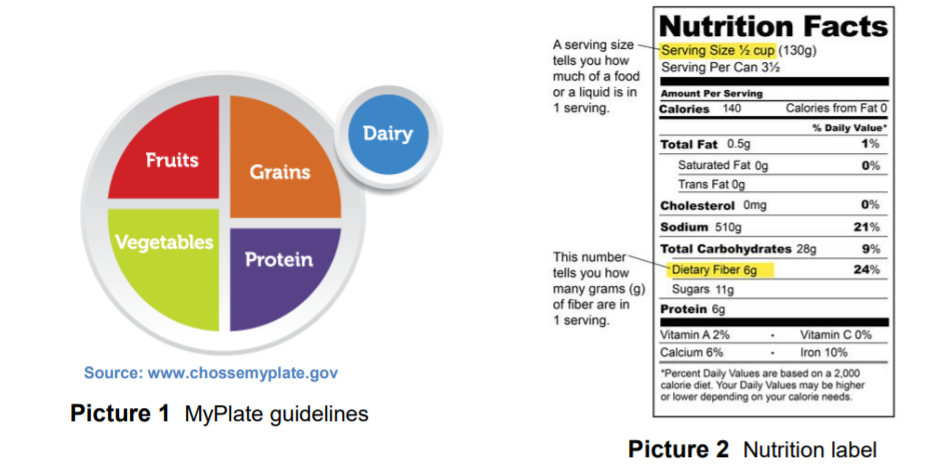High Fiber Diet

To have a well-balanced diet, it is very important for your child to eat 3 meals and 1 to 3 snacks each day. The MyPlate guidelines can help you do this (Picture 1). Half of your child’s plate should contain fruits and non-starchy vegetables. One-quarter of your child’s plate should contain protein such as chicken, beef, pork, lamb, goat, eggs, beans, nuts or nut butters. The final quarter of your child’s plate should have grains or starchy veggies such as pasta, rice, breads, potatoes, peas or corn. Pick foods rich in fiber to fill up your plate.

Fiber is important for normal bowel movements and to help prevent constipation. Exercise and drinking enough liquids also help with bowel movements. Fiber is found naturally in whole grains, fruits and vegetables. Fiber helps reduce cholesterol and control blood sugar. High fiber foods have 5 grams of fiber or more per serving. A good source of fiber has at least 2.5 grams of fiber per serving. Look at the Nutrition Facts label on food containers to increase fiber in your child’s diet (Picture 2).
Types of Fiber
- Soluble fiber is in oats, beans and certain fruits and vegetables, such as strawberries and peas.
- Insoluble fiber is mostly in foods such as whole grains, apple skins, corn and carrots. Foods with insoluble fiber help prevent constipation and reduce the risk of heart disease.
Increasing Fiber in the Diet
- Choose cereals with at least 5 grams of fiber per serving. Good choices include Raisin Bran®, All Bran® and Fiber One®. Sprinkle wheat germ or wheat bran on hot or cold cereal.
- Add beans to meals. Garbanzo, kidney, black or any other beans are a good choice.
- Use whole wheat flour in recipes instead of white flour.
- Choose fruits and vegetables with edible skins (apples, peaches, potatoes).
- Add brown rice instead of white rice as a side dish.
- Pick breads with whole wheat flour or whole grain flour listed as the first ingredient.
- Add dried fruits to your cookies, muffins, pancakes or breads before baking.
- Choose fiber-rich snacks, such as popcorn, raw vegetables with dip, whole grain crackers and high fiber cereals.
Tips to Remember
- Your child should drink more fluids when they eat more fiber. Too much fiber without enough to drink can cause constipation. So increase fiber intake slowly.
- Do not give nuts, raisins, popcorn or seeds to a child under 3 years of age. This can be a choking risk.
- If you want more help increasing fiber in your child’s diet, contact Nationwide Children’s Hospital Clinical Nutrition at (614)722-3060.
HH-IV-1 ©1993, Revised 2021, Nationwide Children’s Hospital
